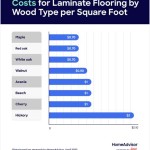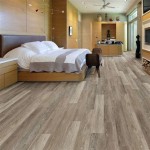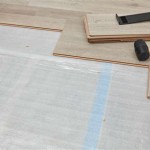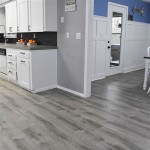Teak Holly Plywood Flooring: A Comprehensive Overview
Teak holly plywood flooring represents a sophisticated and durable option for both residential and commercial spaces. This flooring solution combines the aesthetic appeal of traditional teak and holly planking with the structural integrity and cost-effectiveness of plywood. It is often chosen for its classic nautical appearance, bringing a sense of timeless elegance to interiors. However, its suitability extends beyond aesthetic preferences, encompassing practical benefits like stability, ease of installation, and a relatively lower cost compared to solid hardwood alternatives.
The construction of teak holly plywood flooring involves a multi-layered process. A core of plywood, typically composed of multiple veneers of hardwood or softwood, provides the structural foundation. Bonded to this core is a top layer, or veneer, of teak and holly wood. The specific arrangement of teak and holly in the veneer defines the unique striped or patterned appearance characteristic of this flooring type. The thickness of the veneer layer and the quality of the plywood core significantly impact the flooring's durability and longevity.
The availability of teak holly plywood flooring spans various thicknesses and dimensions, accommodating different project requirements. The finish applied to the surface is another crucial factor to consider. Options include pre-finished flooring with durable coatings like polyurethane or acrylic, as well as unfinished flooring that allows for custom staining and sealing. The choice of finish impacts the flooring's resistance to scratches, wear, and moisture.
Understanding the Construction and Composition
The strength and stability of teak holly plywood flooring are fundamentally linked to its construction. The plywood core contributes significantly to the product's ability to resist warping and dimensional changes, particularly in environments with fluctuating humidity levels. High-quality plywood cores are typically constructed from multiple layers of hardwood, such as birch or poplar, oriented at right angles to one another. This cross-ply construction strengthens the board and minimizes the effects of wood expansion and contraction.
The teak and holly veneer, which provides the visible surface of the flooring, is a thin layer of these two contrasting wood species meticulously arranged. The thickness of this veneer varies, ranging from thin decorative layers to thicker, more substantial layers that offer increased wear resistance and the possibility of refinishing. Thicker veneers allow for sanding and refinishing, extending the lifespan of the flooring and allowing for the removal of scratches or blemishes. However, repeated sanding can eventually wear through the veneer, exposing the plywood core.
The adhesive used to bond the teak and holly veneer to the plywood core is also a critical component. High-quality adhesives provide a strong, durable bond that resists delamination, preventing the veneer from separating from the core over time. The type of adhesive used can also affect the overall environmental impact of the flooring, with low-VOC (Volatile Organic Compound) options being preferable for improved indoor air quality.
Advantages of Teak Holly Plywood Flooring
Teak holly plywood flooring offers several advantages over solid wood alternatives. One of the primary benefits is its dimensional stability. Solid wood flooring is susceptible to expansion and contraction with changes in humidity, potentially leading to gaps, cupping, or warping. Plywood, with its cross-ply construction, is significantly less prone to these issues, making it a more stable option in environments with varying humidity levels. This stability makes teak holly plywood flooring suitable for installation over radiant heat systems and in areas prone to moisture, such as basements and kitchens.
Cost is another significant advantage. Solid teak and holly flooring can be prohibitively expensive, particularly for large areas. Teak holly plywood flooring offers a more affordable alternative, providing the aesthetic appeal of these premium wood species without the high price tag. The cost savings are primarily due to the use of a plywood core, which is less expensive than solid wood, and the reduced amount of teak and holly required for the veneer layer.
Installation is generally easier and faster with teak holly plywood flooring compared to solid wood. Plywood flooring is available in wider planks, reducing the number of seams and speeding up the installation process. It can be installed using various methods, including gluing, nailing, or floating, depending on the specific product and subfloor conditions. The dimensional stability of plywood also simplifies installation, as it is less likely to require acclimation to the environment before installation.
Furthermore, teak holly plywood flooring can contribute to a more sustainable building environment. The use of plywood allows for more efficient utilization of wood resources, as a single tree can yield more plywood than solid wood planks. Sourcing plywood from sustainably managed forests, certified by organizations like the Forest Stewardship Council (FSC), further enhances the environmental benefits of this flooring option.
Considerations for Selection and Installation
Selecting the appropriate teak holly plywood flooring requires careful consideration of several factors. The thickness of the veneer layer is a crucial determinant of durability and refinishing potential. Thicker veneers offer greater resistance to wear and tear and allow for multiple sandings, extending the lifespan of the flooring. However, thicker veneers may also increase the cost of the flooring.
The quality of the plywood core is equally important. Look for plywood cores composed of multiple layers of hardwood, such as birch or poplar, and bonded with high-quality adhesives. The plywood should be free of voids or defects that could compromise its structural integrity. The core's stability directly influences the flooring's resistance to warping and dimensional changes. Choosing a core from a reputable manufacturer ensures consistent quality and performance.
The finish applied to the flooring surface also plays a significant role in its appearance and durability. Pre-finished flooring offers the convenience of immediate installation and typically features durable coatings like polyurethane or acrylic, providing excellent resistance to scratches, stains, and wear. Unfinished flooring allows for custom staining and sealing, enabling homeowners to achieve a specific aesthetic. However, unfinished flooring requires additional time and effort for finishing after installation.
Proper installation is essential for ensuring the long-term performance of teak holly plywood flooring. The subfloor must be clean, level, and dry before installation. Uneven subfloors can lead to uneven flooring and premature wear. It is crucial to follow the manufacturer's instructions regarding installation methods, expansion gaps, and adhesive recommendations. In areas with high moisture levels, a moisture barrier may be necessary to prevent moisture damage to the flooring.

Whole Teak And Holly Plywood Fine Lumber Hardwoods From Carib

Teak Holly Midwest Boat Appeal Marine Plywood

Teak And Holly Plywood Woodchip Marine Lumber

Teak Holly Midwest Boat Appeal Marine Plywood

Teak Tongue Groove Flooring Wood Panels Cabin Sole Yacht Interior Holly Veneer Plywood Marine Maritimewoods Com

Whole Teak And Holly Plywood Fine Lumber Hardwoods From Carib

Teak Holly Midwest Boat Appeal Marine Plywood

Beneteau F235 Faux Teak Holly Sole By Mike Hayden And Carbon Cat

Teak Plywood Ett Fine Woods

Woodchip Marine Lumber Premium Hardwoods Plywoods And Custom Carpentry
Related Posts








